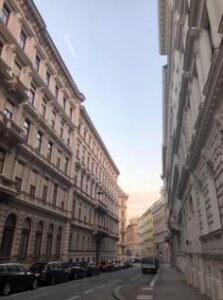Six-month internship in Vienna
- Architecture M.Sc.
- Austria, Vienna

© Amelie Schmitz
- einszueins architektur
- 10/2022 – 04/2023
Preparation:
I applied for an internship at einszueins architektur at the end of September 22 (quite late).
Fortunately, I found a few familiar faces (fellow RWTH students) on the website and therefore had a
little help to get started. A few days later, 1:1 invited me to a very open and cordial online application
meeting. Just 14 days later, I was sitting in the office and had my workplace! Since Vienna has
relatively high living costs, I applied for the ERASMUS + Internship Scholarship, which I can
recommend to everyone. Since I had already been abroad with Erasmus the semester before, I was
well acquainted with the documents and found the application process easy. You can gather your
documents spontaneously at least six weeks before the application. Therefore, it was no longer
possible for me to apply in time, so I could not get the first funding rate. After six weeks, the funding
could begin as planned.
Finding Home:
The search for a flat share in Vienna resembled what I knew from Germany. You can get far with WG-gesucht, but the rush is much higher than in Aachen. The timing of my application was quite bad, so I
had to put up with two interim tenancies (very unproblematic) for the time being. From December
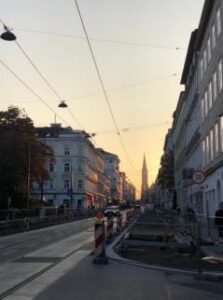
© Amelie Schmitz
onwards, I was able to stay permanently in one place. Vienna is surprisingly cheap (despite being the
capital). You can find all kinds of rooms between 300 and 600 euros. If you are looking for something
affordable, it certainly makes sense not to look in the hottest districts (e.g. 7 and 8). I lived in the 16th
district (Ottakring) and found it very cheap and lively.
Traineeship:
The internship went well, and I am glad to have been at einszueins. Due to the manageable size of 22
employees, I got to know the entire team well and quickly. The bosses attach great importance to a
good group atmosphere, which is why there is an office meeting once a week. Lunch is also freshly
cooked and eaten together in the in-house communal kitchen.
Regarding content, I helped develop a portfolio strategy for Vienna’s first non-profit housing company
and had a lot of responsibility. I was also allowed to help with the competition design for the
Zollhafen in Mainz, which we eventually won. I was understood as an equal team member and rarely
had the typical intern reputation.
Free Time:
The range of leisure activities in Vienna is enormous and varied. Especially art and culture lovers get
their money’s worth. As long as you are under 27 and a student, you can get a reduced rate on many
admission tickets. The Federal Museums Card (59,- for eight different museums) was worthwhile. I
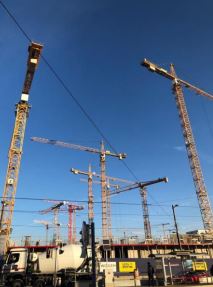
© Amelie Schmitz
attended many theatre and opera performances and various small cinemas with art house films.
Especially in spring, the city wakes up from hibernation, and it’s a lot of fun to explore the area on
foot or by bike. I often went to the Brunnenmarkt on Yppenplatz on Saturdays and enjoyed the sun
there. The Danube Canal is also a little oasis in the city. Everywhere are many authentic cafes and
restaurants where you can pass the time in a tasty way!
Transportation:
Vienna has a reasonably well-developed public transport network consisting of buses, trams, and
underground trains. I opted for the annual pass for 365 euros and canceled it after six months for a
penalty fee of about 20 euros. You get the rest of the money back to travel anywhere for roughly one
euro daily. In addition, I found the offer from the company Eddy Bike excellent. I was able to rent a
high-quality city bike there, which can also be canceled monthly (similar to Swapfiet but local). The
train connections to nearby cities such as Prague, Budapest, or Venice are well-developed and lure
you out of Austria.
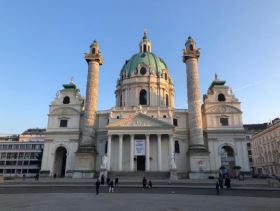
© Amelie Schmitz
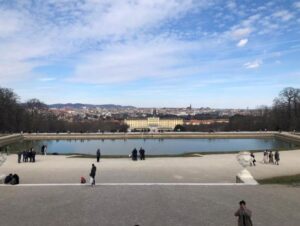
© Amelie Schmitz
Conclusion:
Vienna has proven to be a very liveable city, and I felt very comfortable there. I can imagine spending
more extended time there again or starting my career there. Unfortunately, I didn’t have enough time
to enjoy the nature around Vienna, but I’ve heard it’s also very worthwhile. I highly recommend an
internship in Austria because you have a change of scenery and get to know a different building
culture. Yet, you have hardly any language difficulties and can familiarise yourself with the new
country and working environment. To use the Erasmus+ fund makes much sense to extend the loan
of your internship.
Great experience in Norway
- Medicine
- Norway, Trondheim
- Norges Teknisk-Naturvitenskapelige Universitet
- 02/2023 – 04/2023
Introduction: My Erasmus+ traineeship experience of two months at the Department of Biomedical Laboratory Science at NTNU in Norway was a great experience, personally and professionally. This report aims to provide an overview of my journey, including the application process, accommodation, work environment, and the many activities that can be undertaken in Norway.
Application Process: I found a fascinating paper from the Department of Biomedical Laboratory Science and decided to apply for an internship. First, I called the department to ask about the possibility of an internship. Second, I submitted my application via mail in November. In January, I received a response from the university indicating the need to complete an online application. The whole process was straightforward if you followed the university’s instructions.
Accommodation: Finding accommodation in Norway was relatively easy. Sit, the Studierendenwerk of the NTNU, offers housing to all students (also Erasmus+ Traineeship Students). The rent was affordable, approximately 450 euros, especially when compared to other expenses in the country. Sit provides a range of student housing facilities throughout the city. After being offered a room in Steinan, I asked for a room in Moholt as I had friends from Aachen living there. The staff at Sit is very friendly and changed my offer. In Moholt, there are two types of accommodations: flats for four people with a shared kitchen and bathroom, or “the towers,” where 15 individuals share a kitchen, each having their own bathroom. I recommend “the towers” as they are newly constructed and offer fully equipped kitchens.
Transportation: Trondheim’s bus system is well-planned and provides convenient transportation options throughout the city. The busses come all 10 minutes, later in the day all 20 min. But with 50 euros per month, it is also costly.
Work Environment: On my first day, I received my key card, office key, and an office equipped with a second screen and a work laptop. Although usually an office is shared among three people, the office was mainly only used by me. The work culture in Norwegian labs and the hospital generally is more casual than in Germany. The hierarchy is flatter. For example, everyone gathered for coffee in the morning and had lunch together. Lunch is already at 11:30. I recommend bringing your lunch. That’s also what most others do, as food is expensive. My supervisors ensured that I was trained in every method before I had to work independently. I experienced a high level of appreciation for my work. I was very flexible in planning my lab week, which was cool!
Leisure time: Norway offers a wide variety of (outdoor) activities. If you’re a skiing enthusiast, Trondheim’s cross-country loipes are a must-do, and if you prefer alpine skiing, Vassfjellet is a good destination, located just 30 minutes by car or 60 minutes by bus from Trondheim. Of course, hiking is another great option to enjoy the landscape. Additionally, the university offers mountain cabins for rent (NTNU I member: 4 euros per person per night/ non-member: 8 euros pp pn). Boomerang and BUA are two spots where you can rent outdoor/sports equipment (cross-country ski, snowshoes, sleeping bag, tents, …) for free. If you prefer indoor activities, Sit has several gyms all over the city. There you can train by yourself or book courses. A spot can always be booked 48 h in advance; therefore, you can try out different ones. Apart from the gyms, you can book cheap Squash courts and go bouldering.
Conclusion: I recommend an internship in the Department of Biomedical Laboratory Science at the Faculty of Natural Sciences. The combination of friendly colleagues, a good work environment, and a wonderful country make it a great experience.
Writing my thesis at the Imperial College London
- Chemical Engineering M. Sc.
- United Kingdom, London
- Imperial College London
- 10/2022 – 04/2023
Preparation
Preparing for my time in London was simultaneously very easy and very stressful. For context I had 2.5 months time between my acceptance to the Erasmus scholarship and ICL and the beginning of my time in the UK. For most topics, such as getting a visa, finding a RWTH advisor, getting to London, etc. it was fairly simple to organize every thing. The most difficult task was in fact finding an apartment in London. As this probably takes the most amount of effort, I will start here.
Put simply, the London housing market is very expensive and the number of people searching for apartments seems to far outweigh the number of apartments available. Depending on the location and the size of the room, apartments seem to typically cost between £700-1200 per month, with the average being around £860 based on what I saw and heard from others. I had the most success finding an apartment via the websites Spareroom and Spotahome . If you already have a bachelors degree, Gradpad is another good place to look for apartments. The best method is to start messaging potential landlords early and to try and not be too picky with the offers you get. Many landlords are flooded with requests and will frequently not answer. In such a large city, it is normal to have a commute of 20-30+ minutes to the university, but due to the great public transport, living farther away from the campus should not be too much of a problem. The ICL campus I was located in is found in South Kensington, so I would base my search in the surrounding boroughs (districts). A cheap way to get to university is to take a bike, and the tube is also always a viable (although somewhat expensive) option.
I lived in Battersea and took a bike to and from university everyday which worked really well for me, although cycling in London is not quite as comfortable as cycling in Aachen.
For the duration of my stay, I was informed by the ICL International Student office that I needed to enter the UK under a standard visitor visa which allows a student to study in the UK for a period of up to 6 months. As a EU citizen and German national, I was not required to go through any formal applications or receive any formal documentation as there is an agreement which allows EU citizens to enter the UK as standard visitors without a visa.
Filling out the Traineeship agreement was fairly simple, I wrote a draft version for the agreement myself which I believed best fulfilled the requirements and sent this to both my RWTH and ICL advisors. I would recommend do this yourself and then possibly correcting the agreement as opposed to waiting for this to be done by someone else.
Finding an internal RWTH advisor was done by getting in contact with the Erasmus team from my institute (AVT). I then sent a description of the work which I wanted to do at the ICL (which had been agreed upon with my ICL advisor) and then a suitable advisor was found.
Arrival
Getting to London is fairly simple. There are a large number of airports to fly to, although it is likely the most comfortable to fly to London Heathrow. If you want to take a train, there is also a good train connection to get to London from Aachen. I personally drove my car to London via a ferry from Calais to Dover which allowed me to take a few more things with. This was also surprisingly easy. Important if you choose to drive in London: there is an Ultra Low Emission Zone for which you need to pay to be allowed to drive in London. By simply googling the Ultra Low Emission Zone and how to pay for it, you can save yourself from being fined. As usual with any sort of travel booking earlier is always better.
Living in London
London is a wonderful city to live in full of exciting things to do. No matter what it is you want to do, there is guaranteed to be at least 3 different places where you will be able to do it. There are a lot of opportunities to go out during the day or in the evenings with your friends. Sports, bars, clubs, museums, parks, the list goes on and on. Three things I personally took advantage of were the great selections of musicals that you can visit for a relatively affordable price, the great salsa/bachata dancing scene, and the wonderful green parks. However, being such a large city with so many things to do also means that traveling between locations often takes a significant amount of time (I felt like everything was always at least 25-30 minutes away from wherever I was). My way with dealing with this was to ride a bike between locations and then jump on the tube as necessary. Riding a bike in London requires a certain amount of confidence in your biking skills. The drivers in London are not very good and they tend to pay less attention/respect to cyclists than in Germany. So people won’t be running you over, but you also should be confident in taking space as it is available. Otherwise cars will try to squeeze by you which can become dangerous. That being said, the city is always improving for cyclists and there now exist a number of bike lanes which significantly improved the safety of riding through the city. I rented my bike from Swapfiets which was a great deal for just £19 per month with all repairs etc included, however there are also many Santander rental bike stations spread across the city with which you can also travel.
My impression of living in London is that the city has a lot to offer, and it is up to you to take advantage of it. I was almost always busy thing evening plans. But if you don’t actively look for things you want to do and make plans to do them, then London can quickly become a oversized and anonymous city which is not the best to live in.
Studying at ICL
As a Master’s student writing my master’s thesis, I was left with a lot of independence on how I wanted to study at the ICL. I worked in the Sargent Center for Process Systems Engineering and I was immediately integrated into the center as one of many other researchers. PhDs in the center work in large office spaces with individual desks, which gives a nice mix between social interaction amongst colleagues and still the privacy of your own work space. I was treated no differently from a PhD student and had my own desk from which I could work.
Being at a foreign institute, you are forced to take a lot of responsibility and initiative into your own hands. The professors at the ICL are some of the best in their fields, however they are busy people and expect you to be able to make steady independent progress. I had a weekly-biweekly meeting with my advisor where I could show my progress and get input on problems I was having. But as one would expect of a Masters student nearing the end of their degree, it is mostly up to you to solve small problems and come up with the direction of your work. I found this style of advising similar to my experiences in Aachen, so I do believe that RWTH students are well prepared for this style of work.
It’s important to keep an eye on what you need to do for the RWTH, such as the Erfassungbogen, etc. as the professors in Imperial will likely not know about these things and you will have to help shape your thesis so that it still fill the expectations of the RWTH.
Final Impressions
Overall I absolutely loved my time in London. Imperial is a world renowned university and things I learned have certainly helped me develop in new ways beyond what I learned in Aachen. I would highly recommend anyone thinking about traveling to London and the Imperial college to do so.
Consulting internship in Vienna
- Electrical Engineering and Business Administration M.Sc.
- Austria, Vienna
- Capgemini Consulting Österreich
- 10/2022 – 02/2023
Motivation and formalities: Before writing my thesis, I wanted to take the chance to get to know another business sector and to experience what it’s like to live in the beautiful city of Vienna. Therefore, I applied for a consulting internship at Capgemini Invent. The application process was very quick and the colleagues I met in the process gave me a very good impression of the work culture and lifestyle in consulting. Since I am not European, I needed a work visa, which is theoretically easy to get if you do an Erasmus internship. Unfortunately, the administrative department of the company had no experience with Erasmus interns, so I had to do a lot of research and contact many institutions.
Preparation: I started preparing four months before the start of my internship, and the time was just enough. In my case, the most difficult part was getting the work permit, but in general I would say that after accepting the internship offer, the only thing you have to prepare is the accommodation. I looked for a shared apartment in WG-Gesuch because I didn’t know many people in Vienna. I was very lucky to find a very friendly, open and helpful flatmate. The apartment was very modern and spacious and was located in the 16th district and very well connected to the office, but also to the city center and only 10-15 minutes away from my favorite cafes and bars in the 7th district. To get there, I took the night train from Aachen to Wien Meidling Bahnhof (and then the subway to the apartment) 10 days before my first day of work, so I could settle in well in Vienna. I can only recommend this, because during this time I was able to enjoy the warm September days, take care of some organizational things, get to know my flatmate better and meet people who are now very good friends of mine.
- Internship Search: I found the internship through LinkedIn and didn’t apply to anyone else because they got back to me very quickly and made a very good first impression.
- Apartment search: Via WG-Gesucht. I would 100% recommend a WG. I have also heard of other search portals like housing anywhere or willhaben. There are also accommodations in the STUWO dorms and many private and very modern student apartments.
- Phone or bank/account opening: Was not needed.
Formalities on site:
- Health insurance: My colleagues and I were automatically insured by ÖGK. For the insurance card, I had to submit a photo and it was delivered to my apartment. I then went to the general practitioner with the card. That worked very well.
- Everyone has to register their address and also deregister when they move out.
Everyday life/leisure: The five months in Vienna were a wonderful experience. Since I arrived at the end of September, I was able to do some wine hikes at Wilhelmina Berg, Kahlenberg and Nussberg. As well as a grills and chillings by the Danube. In the colder months my friends and I spend time in various museums (recommend the long night of museums; Mumok, Albertina, Albertina Modern, Leopold and the Kunsthistorisches Museum), bars (Monami, Café Anno, Prosecco Bar, Liebling), cafes (Ramasuri, Wirr, Ulrich & Erich), exhibitions, small concerts, pop up vintage stores and the Naschmarkt.
I can also recommend a visit to the ballet, the opera, a musical and a Christmas concert. During the Christmas season, there is a Christmas market on almost every corner. My favorite is the one at Spittelberg, but the Christmas market at Spittelberg and the one at Schönbrunn are also worth a visit or two. You also have to keep in mind that during the week I could only go out for dinner or drinks because I worked around 50 hours a week, but on the weekends I could enjoy everything Vienna has to offer. As for sports, my flatmate, some friends and I were members of “myClubs” (like Urban Sports in Germany) and could visit many different studios in the city. Another option is to sign up for university sports classes (USI).
- Going Out: There are many cheap and also fancy bars around Schwedensplatz and also in the 6th, 7th and 8th district. My favorites are the ones mentioned above. For live music, there are many bars on the “Gürtel”. For partying, my favorite clubs are Grelle Forelle (mostly techno) and Volksgarten (eclectic and mostly commercial music), but there are many others (Pratersauna, Praterdom, O Club, VIP, etc.). I’ve been to Vienna in the colder months, but I’ve heard there are lots of raves and outdoor parties in the summer.
- Culture shock: Only positive things! My flatmate was very welcoming and introduced me to her friends. At work, everyone was also very friendly and we did many activities together outside of the office. There were many new young co-workers like me, so it developed into a nice friendship. At a salsa night, I met some Erasmus students with whom we explored the city together and created unforgettable memories. I hope to see them again soon!
Internship in Dublin
- Applied Geography B.Sc.
- Ireland, Dublin
- University College Dublin
- 11/2022 – 02/2023
Application and Preparations
I first started considering an internship abroad in spring 2023, roughly 10 months before I left. Looking back, this period turned out to be exactly the right amount of time to prepare. I decided to visit Ireland because I was curious about the culture and the landscape as well as the fact that besides German, I am only fluent in English. I got in contact with the international office of University college Dublin who advised me to simply reach out to a staff member whose work interested me. After securing the position I went on to apply for Erasmus funding. The next step after that was looking for accommodations which turned out to be very difficult, but more on that later.
The Internship itself
I was very nervous about my internship as I had never been alone abroad before and while I do study geology as a minor it is not my area of expertise. However, I am very happy that I decided to take the leap, as it turned out that I was greeted very kindly and got all the support I could have ever asked for. I got a research project to work on for the duration of my stay and plan to continue to foster the relationships that I have built. A typical workday for me lasted from 9-5, and consisted of meetings with colleges to discuss results and exchange ideas, as well as working on my tasks in my shared office. Without going into too much detail, my project was mainly focused on the dynamics of sinkhole development at the dead sea in Jordan. Besides that however, I was also invited to join fieldtrips to beautiful beaches in the south of Dublin and help the PhD Students wherever I could.
Living in Dublin
Before coming to Dublin, I had heard people talk about the city being shockingly expensive, but I underestimated how much I would end up spending on basic necessities. In the last few years, Dublin has experienced a major housing crisis, leading to very few flats available and horrendous prices. A small room that’s barely furnished can easily cost you up to 1000 EURO a month, even if it is far out from the city centre. In addition to that, groceries are much more expensive than in Germany, which is important to keep in mind when planning finances ahead of time. Therefore, if you do not have savings or a sufficient income during your stay, it is really not possible to afford the city
During my stay, I have been told that I visited during the wrong time of the year a bunch of times, and I unfortunately must agree with that. While the windy weather didn’t fade my enthusiasm, the short dark days that tainted the city into a grey boring mush did. While Celtic influences in the city are hard to miss and Trinity College is stunning, it still feels like a typical European city that doesn’t really offer anything new. Good coffee is generally also somewhat hard to come by, but I strongly recommend paying Vice a visit for their specialty coffee.
When it comes to Public Transportation, applying online for a leap card can save you a lot of money. Generally, inside of Dublin the best form of transport is the bus. 90 Minutes and unlimited transfers will cost students only 1 EURO. Bus services are rather unreliable however, and as in every major city tend to be very cramped.
What I loved most, was Irelands open culture that made it easy to connect with my colleges and lead to the formation of great friendships. Drinks after work on a Friday are a common and welcoming occurrence in Dublin, so be prepared.
Conclusion and advice for other people seeking out adventures.
I would always recommend people to go on and move abroad, even if it is just for a short period of time. I meet great people and saw many new placed. Staying abroad while also working is a very intense period of time and can definitely be exhausting. Homesickness will most likely occur, but in the end the benefits overweight by far. I have been granted many opportunities during my stay that are extremely beneficial towards my career, and I am beyond grateful for that privilege.
Unexpected chance in Slovenia
- Architecture M.Sc.
- Slovenia, Ljubljana
- Arhitektura Krušec
- 10/2022 – 03/2023
Living in Ljubljana
My internship in Slovenia happened by pure, lucky coincidence. During my last internship in Sevilla in the spring of 2022 I met some Slovene people, among them a university professor for architecture of the university in Ljubljana. I told him that I still needed some more months of internship and he suggested to apply at his office. Since until that point I did not know anything about Slovenia and I really liked the people I met, I decided to take that chance and applied.
I arrived to Ljubljana in the end of September 2022 and had one week to explore the city before the work started. In this week I had the great luck to meet some Erasmus students that came to study for a semester in Ljubljana. Through them I continued to meet new international people during my whole stay, which was truly amazing!
I lived in an apartment right in the city centre, two minutes walking from the Prešeren square. It was in a beautiful old building that I shared with five other students among them also some Slovene students that also became really goof friends of mine. Apparently, I was lucky to find a room that I didn’t have to share because after my arrival I found out that it is a very common concept in Slovenia for students to share rooms. Because of its great location we would often have gatherings at my place.
In the architecture office I had eight colleagues plus the bosses (plus the office dog, an amazing Border Collie). The atmosphere in the office was really good, like they are all friends, and half of my colleagues were more or less my age, which was also very nice for me. They tried to speak a lot of English to include me but to each other they obviously would speak Slovene, which I – surprise – did not understand at all. You do not really need to speak Slovene to live here because most people speak English perfectly, but I wanted to learn at least the basics. For a reason that I don’t know there is a lot of videos on YouTube about Slovene Grammar. If you want to learn this language and have no experiences with Balkan languages, I recommend watching those. Another thing that really helped was getting a book, that I know very well in German, in Slovene. That made it much easier because I didn’t have to look up every word. After the six months of internship, I am still very far away from being fluent in Slovene, but I can read a lot and understand more basic conversations. If you come here, I definitely recommend giving it a try.
The work in the office was diverse. They gave me a lot of different tasks, which I am very grateful for. I was participating in the design phase for new projects, make models, draw execution plans, edit renderings,… I learned a lot of things that I will be able to apply in the upcoming years of my studies.
Apart from the work I had a great time in Ljubljana. Slovenia is very small but has a very diverse and beautiful nature. You can do a different trip every weekend and not run out of nice places to visit. And since Ljubljana is located basically in the centre of the country, all the destinations are reachable in like two hours by car. Very fascinating are for example the Soča Valley, Zelenci Lake, Velika Planina, Bohinj and the Vintgar Gorge. The nature is so abundant and I recommend exploring it even if it is just for a vacation!
Ljubljana is the biggest city in Slovenia and has a population of roughly 280.000 people, which means, considering it is the capitol, it is very cosy. But it is not only the comfortable size that makes it cosy. The centre consists of old but mainly well-preserved buildings, everything is clean and green. Also, the centre is free of cars which is amazing for pedestrians. There are always people on the streets, even in winter people would sit outside of the cafes and restaurants to drink their kuhano vino, mulled wine, next to the fire.
The original plan was to do an internship of three and a half months. But I soon decided to extend it and stay in the office six months. Even after finishing the internship, I will stay six weeks longer now to explore more of this country, enjoy the city and see the spring.
I will keep taking unexpected chances like this one – they might hold something great.
Falling in love with Vienna
- Architecture M.Sc.
- Austria, Vienna
- AllesWirdGut Architektur ZT GmbH
- 09/2022 – 02/2023
In September 2022 I started my 6-month long internship at AllesWirdGut Architekten in Vienna, Austria. As Austria’s capital and its largest city Vienna offers a multitude of diverse activities. Its stunning historic architecture and impressive offer of culture and art made the city so appealing to me.
Before I moved to Vienna, I researched different architecture offices in the city. Finding the right office for me was at first a bit overwhelming, as it was my first experience
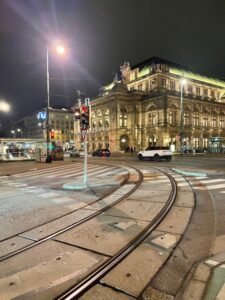
© Pauline Linka
working in an actual office and I wanted to gain insight into various parts of the office life. Furthermore, I wanted to be able to identify with the office’s style. When searching for offices to apply to, I recommend checking out their social media presence. Most offices have an Instagram page, which not only shows their projects but often also gives an insight into the daily work environment and the general atmosphere.
After finding an internship, I started looking for a room to rent on WG-Gesucht. From my friends I know that finding a room can take some time but I found that after investing some time in writing an informative message about yourself and taking part in a few WG-Castings I was able to find a nice room in a great location quite easily. I found a room in the 3rd district, close to the Belvedere and with a great public transport connection to my office. Compared to ot
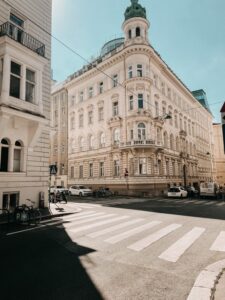
© Pauline Linka
her large cities rent in Vienna is quite low and there are many beautiful his toric apartments available for rent. However, I recommend looking for an apartment with roommates, as single apartments tend to be more expensive and as an added bonus, living in a shared apartment is a great way to make friends when moving to a new city. There are also many possibilities to rent an already furnished room as I did. That definitely made moving much easier. Another important factor when looking for an apartment is the location. In general Vienna’s public transport system is very reliable and well connected, which makes it possible to also move to the outer districts. Nonetheless I would recommend looking for places with in the first 9 districts, they all offer different cultural sights and are very lively and well connected. The 10th district is known to be unsafe and not the most desired living area however over all Vienna is a very safe city and as a woman I never once felt unsafe, even when walking home alone at night.

© Pauline Linka
After finding a place to live, there are a few more things that need to be taken care of. The first thing after moving into the new apartment should be a visit to the closest municipal district office to register the new address. My health insurance was covered by my employer and all I had to do was to apply for my Austrian E-Card with my Austrian social security number, however even without an E-Card there are no problems when going to the doctor, they also accepted my German insurance card.
I arrived in Vienna a few to days before my internship started, to get settled and to explore the city. Besides seeing all the major sights, I really enjoyed just walking around and exploring the city away from crowds. Another great way to see Vienna’s sights is taking the tram or Bim as it is called by the locals, the lines 1, 2 and 71 drive by the opera, the city hall, the parliament, the Volksgarten and the Hofburg. While the 1st district is often overcrowded by tourist
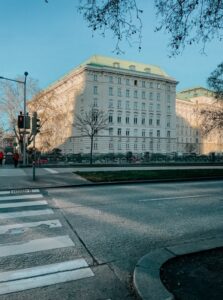
© Pauline Linka
s, checking out the Stephansdom and the Hofburg are mandatory. Besides that there are many famous cafes, bars and restaurants located here. The best Schnitzel is served by Figlmüller, which has three locations in the 1st district. It’s usually booked weeks in advance and a reservation is recommended. In general but especially on the weekend reservations are mandatory to explore Vienna’s diverse cuisine, not only restaurants but also bars, are usually booked fully from Thursday to Sunday. I also recommend trying a piece of Sachertorte or some traditional Kaiserschmarrn at Café Demel, one of the oldest Coffeehouses and bakeries in Vienna. Personally, I prefer the Sachertorte at Café Demel over the one at Café Sacher, but there are entire guides about finding the best Sachertorte in the city. It’s a thing. Also ordering a “coffee” in a Viennese Coffeehouse will get you a concerned look from the waiter and a lecture on coffee, so I recommend ordering a mélange, the viennese version of a cappuccino. However the fact that Vienna besides being voted the most livable city repeatedly is also supposedly the unfriendliest city, cannot be confirmed. Unless you count the waiters in a traditional coffeehouse.
I experienced the people in Vienna as very open and welcoming. I found it was quite easy to make new friends, however I was also very lucky, as there were quite a few interns at the office I worked at, which made it easy to connect with new people.
In general, I had a great experience in Vienna. I really enjoyed working in an architecture office and learned a lot. During the last 6 months a made amazing new friends and fell in love with the city a bit more everyday. Even though I used every free minute after work or on the weekends to see more of the city, there is still so much left to explore. That and the fact that I instantly felt at home in Vienna led to my decision to stay and finish my Master in Architecture at the TU Vienna.
Internship in the Republic of Northmacedonia
- Practical Year in Medicine
- Republic of Northmacedonia, Skopje
- University Clinic for Dermatovenerology
- 01/2023 – 03/2023
My experiences:
Preparation: To organize this internship was fairly easy. The person responsible at the university is very responsive and very organized. Within two days, I had the acceptance from the department of dermatology. Once you are accepted, start preparing for the visa. It’s nearly impossible to reach the embassy in Berlin via phone and I recommend to prepare all documents and then go there directly. They will then tell you if something is missing. Just a hint here: The criminal record needs to have an apostille and you will need to translate all documents into Macedonian. If you translate it from English, you can reach out to official translators in Macedonia. They are very reliable and work quickly.
To bring: You should bring scrubs, a coat and a stethoscope, etc. As a nice gesture, do not forget to bring some souvenirs from your city.
Language: I was amazed by the advanced level of English the general population has. As they do not dub their movies, nearly everybody understands English and speaks it. However, I recommend making an effort to learn Macedonian. A great book to learn it is ‘Macedonian: A Course for Beginning and Intermediate Students’ by Christina E. Kramer and Liljana Mitkovska.
Health: While technically the European insurance card is valid, I recommend getting a private health insurance. Prices for consultancies are affordable and you will not wait longer than a few days to see a specialist. I went to the dentist here and I got an appointment within one day. The quality of care in the private sector is very good.
Safety: Macedonia and Skopje are very safe. Even when walking through the city at night alone, I never felt unsafe.
Money: In most places you can pay cash or by card. It’s good to always have some additional cash with you as some places – especially in the rural areas – do not accept card payment. If you have an apobank credit card, use the atms from Hallbank. They do not charge any fee.
Shopping: The cost of food in the supermarkets is comparable to Germany. However, going out to eat is considerably cheaper and activities such as going to the ballet/opera cost around 5€.
Transportation: Skopje has very cute double decker busses which are well connected. However, as I lived close to the hospital, I walked there. As the city center is quite small, most of the major sights and places are in walking distance. If you plan to travel within Macedonia, check out the bus companies at the bus station. At very reasonable prices you can go nearly everywhere. Biserprom is a bus company that offers weekend or single day travels. Check out their Facebook page. I went to Mavrovo (a great ski resort) and back for 5€.
Communication: As Northern Macedonia is not part of the EU-roaming packages, you will need to buy a separate SIM card. I recommend choosing A1, which has monthly packages for 300MKD (approx. 5€) 20GB. The internet connection with the mobile phone is super stable and coverage is great. Even when hiking, I never lost network.
Accommodation: To find a flat, have a look at AirBnB, Facebook (group: Skopje expats) and reklama5. In general, prices for a flat should be around 200-300€ – you can of course find cheaper rooms in the outskirts. I lived in Kisela Voda, which was a great and quiet neighbourhood.
Travel and arrival: There are numerous air- and buslines that go to Skopje. I travelled with bus (32h drive) for approximately 100€. While they do take breaks every 1-2hours, it is not the most comfortable way to travel. If you decide to go by plane, you can take a taxi or a bus which runs every 3-4h to the city.
Work routine: The mornings start with a short round of patient visits and then a morning meeting with all staff at 08:00. Afterwards, you continue to see the patients together with the specialists. On Wednesdays, all staff does a round together to see all patients. After the morning round, you can choose which specialist you want to join. Most doctors are happy to explain everything to you while they treat the patients, which is very helpful to understand the conditions of each patient.
Free time: Skopje is a great place to be in the nature and hike. In walking distance from Skopje center, there is Vodno mountain which offers a great view of the city. Near Skopje, there is the Matka canyon which features underwater caves whose depths haven’t yet been explored fully. The Vrelo cave is with its explored 240m already one of the deepest caves in Europe and the world. Another place worth an excursion is Ohrid, a beautiful city three hours south of Skopje. It is bordering the lake Ohrid, one of the oldest lakes in the world. In Ohrid, there were 365 churches/chapels – one for each day of the year. While not all still exist, there is a significant amount of them one can explore. If you are less into nature, have a look at the numerous great coffee bars Skopje offers. At nearly any time, you can see people chatting and drinking coffee there. The old bazar is also a must see.
My stay in the modern town of Delft
- Robotic Systems Engineering, M.Sc.
- Netherlands, Delft
- Delft University of Technology
- 08/2022 – 02/2023
I am a master student from RWTH Aachen, Germany. My first impression of Delft was that it is a very clean and modern town, which is reflected in the clean and tidy train station. The greeting drivers on the bus, the friendly waiters in the restaurants and the passers-by who welcomed me to Delft all proved the warmth of the people there.
Culture shock
The biggest culture shock was the heavy use of bicycles. In Aachen, bicycles are not the most dominant mode of transportation, probably because the city is not very big and some of the roads are not smooth. But Delft has a surprisingly large number of bicycles, and it certainly is the most dominant form of transportation in Delft. There are two-way bike lanes on both sides of Delft’s roads, which provides a huge convenience for cycling. Therefore, if you are coming to the Netherlands for an internship, my most recommended mode of transportation is by bike. Another culture shock is the book bags hanging in front of many houses. I didn’t know much about this phenomenon at first, but after asking friends and checking the internet I realized that hanging school bags is how Dutch students celebrate graduation. Another interesting phenomenon is the way people relax

© Disen Wang
on weekends, which is boating. This is a phenomenon that can only be seen in parks in China and Germany. Probably because there are many rivers in Delft, I found that many families have their own boats and have the habit of boating, which I think is a very interesting way to have fun. The most comfortable thing for me is the widely use of English and the cashless shopping, which is not available in Germany. The English language is so widespread in the Netherlands that you can live in the country without any problems even if you don’t speak Dutch. I don’t need to carry a lot of cash every day because of the wide use of cards payment. One thing I don’t quite understand is that when it comes to cash transactions, the smallest unit is 5 cent, and they won’t give back any change less than 5 cent. I hope you won’t stand at the counter like me and wait for them to find the money.

© Disen Wang
Health insurance
As an international student with German insurance, it is not difficult to visit a doctor in the Netherlands and you do not need to apply for new insurance. You can use your German insurance to visit a doctor in the Netherlands, but the process is a bit different than in Germany. The German insurance card cannot be used directly in the Netherlands, so you need to pay for your own medical expenses first and then fill in the reimbursement information on the German insurance company’s website. I went to the dentist in Delft, and I was able to get reimbursed by my German insurance company for both the doctor’s visit and the medication. However, not all medications are reimbursed, and some may not be covered by insurance. My total cost was 97.11 Euros and was finally reimbursed 92.11 Euros, and the result of the review was issued within a week, which was acceptable to me. Of course, I still hope you won‘t get sick!
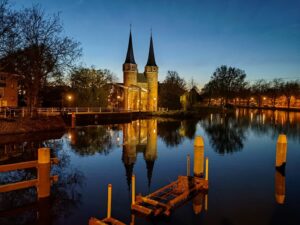
© Disen Wang
Travelling
First of all I would like to start with a few words about train rides. Unlike Germany, you need to go through ticket machines to enter and exit the stations in the Netherlands. In addition, the ticket prices in the Netherlands are fixed and do not change with the date of purchase like in Germany, which is very friendly for people who do not like to plan their trips in advance. I also highly recommend getting an OV chip card, which can be used for most trains and buses in the Netherlands, so you only need to swipe it when you get in and out of the station, no need to buy tickets online. Rotterdam is a very modern and clean city with a lot of skyscrapers, which is not like a typical European city. The Kinderdijk, located near Rotterdam, is one of the most impressive tourist attractions for me. The beach in Den Haag is very beautiful and I like it best in the evening, when the crimson sunset shines on the beautiful clouds and the beach, and you can see some boats and windmills in the distance. Amsterdam is also a city I really like, it is more historitic compared with Den Haag and Rotterman. The Royal Palace of Amsterdam is gorgeous. The Van Gogh Museum and the Dutch National Museum are also well worth a visit. Another point worth mentioning is
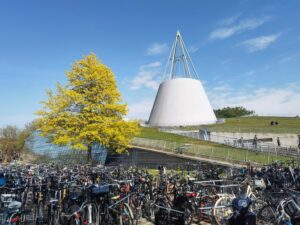
© Disen Wang
that most of the attractions in the Netherlands have audio guides in several languages, including but not limited to English, Chinese, Dutch, French and German, which is really friendly to foreign visitors. The following pictures were taken by myself. The first three are in Delft and the last one is in Kinderdijk.
All in all, I really enjoyed my visit to the Netherlands. If you also like to explore different cultures, please don’t hesitate to come to the Netherlands, you will never regret it.
Incredible experiences in Paris
- Computational Engineering Science B.Sc.
- France, Paris
- Wiremind
- 10/2022 – 03/2023
Application/ finding an internship
Since I went to Paris in august 2021 for two exchange semesters at a university, I decided that I’d like to stay longer. The resulting conclusion for me was therefore to search an internship in Paris. I’m currently enrolled in a Bachelor of Computational Engineering Science. For this cursus it is mandatory to make an internship that lasts at least three months at the end of our studies.
Luckily, I already collected some recommendations for the application process in France during my time at the university over there. I sent two applications to start ups in Paris. The application process for the two positions included first an online test and afterwards a personal meeting where I introduced myself and presented what I’ve coded in the exercises before.
To search for open job positions I can highly recommend having a look at welcometothejungle.com. This platform is used by startups as well as larger, classical companies (e.g., L’Oréal). The company where I made an internship as “Junior Full Stack Software Engineering Intern” is called wiremind. They offer optimization solutions in the context of transportation.
Concerning the language, I can highly recommend having already basic knowledge in French before the internship. During my internship I met some people who are not speaking French neither are willing to learn it. Not speaking French is in general not a real problem in the background of business questions, but it is difficult to integrate in the French culture and find friends (that are French) if you don’t know their language. Besides of this, no French person is going to judge if you try to speak French, but you are not yet fluent. I met a lot of people who had German in school and they where always impressed by French, because they compare it to their knowledge of German.
Accomodation and living expanses
Paris is a very expansive city. During my internship I earned 1500€ of salary (brut). It is common in France that the employer pays the half of the transportation per month. Another particularity of working in France is that they hand out restaurant checks to the employees. In general, the company pay for 20 days 5€ per day and they subtract directly 5€ from the employee’s salary and add it to those restaurant checks (around 160€).
The cost for an appartement varies between 750€ and 1300€ for small appartements. It highly depends on the location of the appartement. As an example, I’m living with my boyfriend in a 32 square meters appartement with two rooms that is fully equipped, and we pay around 1500€ in the “quartier latin” near to the Pantheon. I met many people who are living outside of Paris in the banlieu to save some money.
I would all the costs are higher in Paris especially in comparison to Aachen. Thanks to the inflation in Germany, it feels like the difference for food prices in comparison between France and Germany is decreased, but this could as well be just a feeling.
Everyday life / the internship
During my internship of six months, I got six days of vacation. Personally, I really appreciate the working hours in Paris. Normally I’ve started around 9:30 am and worked until 6:15 pm. In the lunch break we were making some sport or playing FIFA or Mario Kart. According to my contract I’ve worked around 35 hours, which is the legal limit in France.
Free time / tips
Paris is a city which is not only incredibly beautiful but also busy city. If you are under 26 the most of the museums are free. I’ve started during my internship to go running with my colleagues in the lunch break. After 5 months I made a half marathon together with one of them. There exists an entire running culture in Paris. During the week at around 12 am there are many runners at the quay of the Seine (which is stunning with sunshine). Another advantage of living in Paris is the fact that from Paris you can reach nearly every important city in France by train without switching the train. Staying for some time in Paris gives you the opportunity to discover France.
Conclusion
I would do it the same way again and again! My internship was incredible in terms of my tasks and my colleagues. I really appreciate every second I could spend at wiremind!
As I mentioned before, I highly recommend to already speak French or at least being willing to learn and speak it. Especially if it comes to jobs where you need to interact with customers it is necessary to speak French. Furthermore, I recommend Paris as city for an internship. Since I’ve already done an Erasmus exchange at a university in Paris and an internship in Paris, I tend to recommend the internship. In my opinion Paris itself is not a student town. It’s too large and honestly just too expansive if you have no income like a salary due to an internship.


